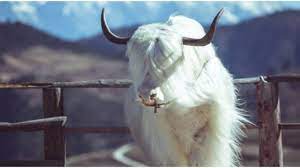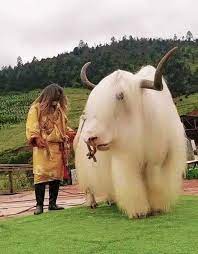In the rugged terrains of Tibet, a symbol of resilience and adaptability roams—the Tibetan Yak. Join us as we journey through 48 captivating facts about this remarkable bovine, exploring its unique attributes, cultural significance, and the essential role it plays in the lives of Tibetan people. From its impressive horns to its contributions to the high-altitude ecosystem, the Tibetan Yak’s story is one of strength and the intricate connection between nature and tradition.

1. High-Altitude Home: The Tibetan Yak thrives in the challenging environments of the Himalayas.
2. Yak Facts: They belong to the bovid family and are close relatives of cattle.
3. Coats of Comfort: Their long, dense coats protect them from extreme cold.
4. Dual Purpose: Yaks provide both milk and meat to local communities.
5. Milk Marvel: Yak milk is highly nutritious and a staple in Tibetan diet.
6. Woolly Wonders: Yak wool is used for clothing, blankets, and tents.
7. Oxygen Efficiency: Their unique lung structure aids breathing at high altitudes.
8. Ecological Balance: Yaks play a crucial role in maintaining mountain ecosystems.
9. Ponderous Partners: They are commonly used as pack animals in rugged terrains.
10. Adaptive Abilities: Yaks can survive on sparse vegetation and low-oxygen conditions.
11. Social Structure: Yaks live in herds led by a dominant female.
12. Silent Communicators: Yaks communicate through body language and vocalizations.
13. Longevity Legends: Some yaks live up to 20 years in the wild.
14. Farming Companions: Yaks help plow fields in some Tibetan communities.
15. Yaks in Mythology: They hold cultural and spiritual significance in Tibetan beliefs.
16. Transport Treasures: Yaks are invaluable for transporting goods in remote areas.
17. Vital Economy: Yaks contribute to the livelihood of Tibetan nomads.
18. Yak Cheese: It’s a delicacy derived from yak milk, cherished by locals.
19. Climate Adaptation: Yaks are well-suited to cold, harsh climates.
20. Domestication History: Yaks have been domesticated for thousands of years.
21. Biodiversity Boosters: Their grazing patterns influence plant diversity.
22. Sacred Symbolism: Yaks are revered in Tibetan religious practices.
23. Climate Change Challenges: Yaks face threats from changing weather patterns.
24. Traditional Textiles: Yak wool supports the creation of traditional clothing.
25. High-Altitude Grazers: Their diet mainly consists of tough grasses and shrubs.
26. Conservation Concerns: Protecting yak habitats is essential for their survival.
27. Yak Butter Tea: A staple in Tibetan cuisine, known for its energy-boosting properties.
28. Farming Traditions: Yaks are integral to the Tibetan pastoral way of life.
29. Oxygen-Transport Champions: Their blood’s high oxygen affinity aids altitude living.
30. Himalayan Heritage: Yaks are deeply intertwined with the region’s culture.
31. Artistic Inspiration: Yaks are subjects of Tibetan art and crafts.
32. Economic Support: Yak-related industries contribute to local economies.
33. Migration Masters: Yaks undertake seasonal migrations for grazing.
34. Endurance Athletes: They trek long distances in challenging terrains.
35. Yak Dung Fuel: It’s used as a source of energy for heating and cooking.
36. Yak Horn Products: Horns are used to craft various items, from utensils to jewelry.
37. Community Cohesion: Yaks foster communal cooperation among herders.
38. Mountain Guardians: Yaks are essential for safeguarding mountain ecosystems.
39. Nutritional Powerhouses: Yak products offer sustenance and nourishment.
40. Ritual Significance: Yaks are integral to traditional ceremonies.
41. Conservation Collaborations: Efforts focus on yak habitat protection.
42. Ethical Use: Responsible yak farming promotes animal welfare.
43. Cultural Resilience: Yaks embody the endurance of Tibetan culture.
44. Milk Traditions: Yak milk is used to create various dairy products.
45. Ecosystem Engineers: Their grazing impacts plant growth and distribution.
46. Yaks in Literature: They feature prominently in Tibetan literature.
47. Symbiotic Connections: Yaks foster connections between humans and nature.
48. Cultural Continuity: Yaks play a role in preserving Tibetan heritage.



















Add Comment